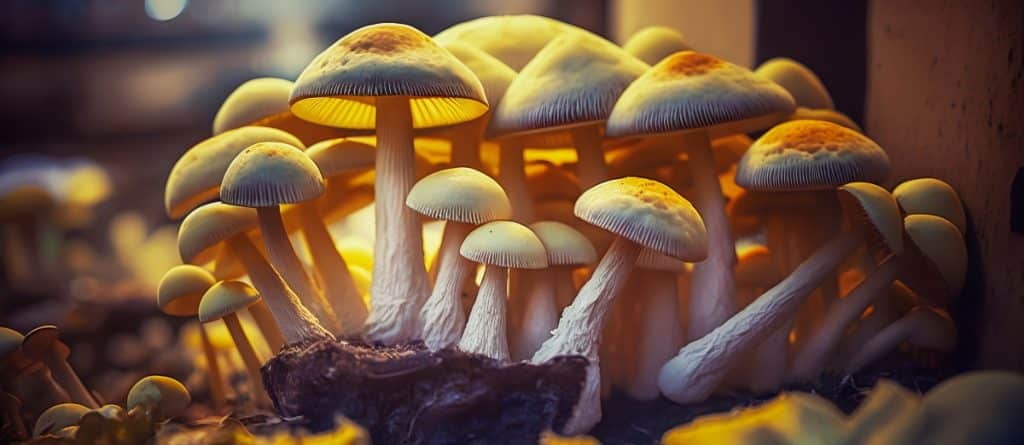Growing mushrooms at home is a rewarding way to have an ongoing supply of delicious gourmet or medicinal mushrooms, and you don’t need much to get started.
One of the most important things you’ll need to do is provide ideal fruiting conditions for your mushrooms, including the right amount of light.
This may sound strange, as many people are under the impression that mushrooms grow in the dark.
So, do mushrooms need light or not?
Read on to learn if mushrooms need light, what light does to them, how much light they need and which lighting is best for mushrooms.
Do Mushrooms Need Light?
Mushrooms don’t need light to grow, but light affects them, and providing indirect light for your mushrooms will lead to larger yields and well-formed mushrooms.
Some of the world’s most commonly cultivated mushrooms, button and enoki mushrooms, are usually grown in the dark, creating the misconception that all mushrooms grow in the dark.
But most other mushroom varieties need some light during the fruiting phase for their fruit bodies, which we call mushrooms, to develop properly.
To clarify, the delicious produce we call mushrooms are actually the fruiting bodies of a fungus that’s often hidden from sight. Mushrooms are formed as part of their life cycle and serve a similar purpose to the fruit produced by fruit trees.
But, unlike plants, fungi don’t need light to produce food and grow, as they don’t photosynthesize.
Instead, fungi get the nutrients and energy they need from the organic material around them. Mushroom mycelium, the main body of the fungus, can spread and digest organic material without light.
But when it’s time for fungi to produce mushrooms for reproduction, light plays an important role.
Why Are Some Mushrooms Grown in The Dark?
Button and enoki mushrooms, commonly found in grocery stores, are intentionally grown in the dark to produce pale mushrooms with smaller caps.
Enoki is also grown with high levels of CO2 to encourage the production of long thin stems.
The history of mushroom farming also provides some insights as to why many people believe mushrooms only grow in the dark.
During the 17th century, mushroom cultivation became popular in Europe, and French cultivators developed a method for growing mushrooms in caves.
This was not to prevent light from getting to the mushrooms but to provide ideal growing conditions.
Caves have constant, cool temperatures and the correct humidity levels for mushroom cultivation.
Several other European countries adopted this method, and it became the standard way of growing mushrooms until new technologies allowed climate-controlled growing environments.
Today, the Cave des Roches at Bourré in France is the only remaining underground mushroom farm. They use old-fashioned cultivation methods to grow pied bleu, oyster, shiitake and button mushrooms.
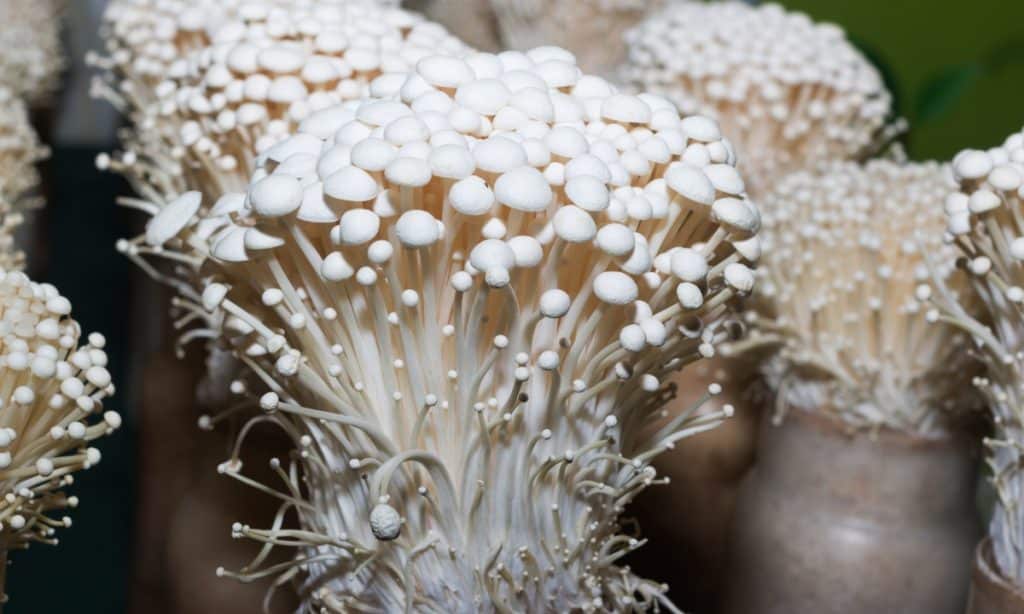
What Does Light Do to Mushrooms?
Although mushrooms don’t need light to grow during incubation, light is often crucial for pinning initiation and proper cap formation during the fruiting phase.
In the wild, several factors help a fungus know it has reached the surface of the substrate and can produce mushrooms. Daylight is one of these factors as well as more fresh air and lower CO2 levels.
Here are some of the noticeable effects that light has on mushroom growth:
- Triggers mushroom pinning
- Ensures proper mushroom formation. Several varieties will grow long and stemmy without enough light.
- Darkens cap color
- Increases cap size
- Exposure to sunlight increases vitamin D levels
What Is the Best Lighting for Mushrooms?
Although light requirements vary from species to species, mushroom cultivators generally agree that indirect sunlight or white or blue wavelength 6500K – 9000K artificial LED lights are best.
Beginner mushroom growers often grow mushrooms close to a window using indirect daylight. But, for more control, a fruiting chamber with artificial lighting is a popular option.
Which is best will depend on your needs, the mushroom species you’re growing and the amount of mushrooms you want to grow.
Pros and Cons of Artificial Lighting
Pros
- You have more control over the amount of light your mushrooms get
- You can grow your mushrooms in enclosed grow tents or rooms
Cons
- You’ll need to buy lights
- Unless automated, you’ll need to switch them on and off
- If there’s a power cut that’s not fixed quickly, it could ruin the whole crop
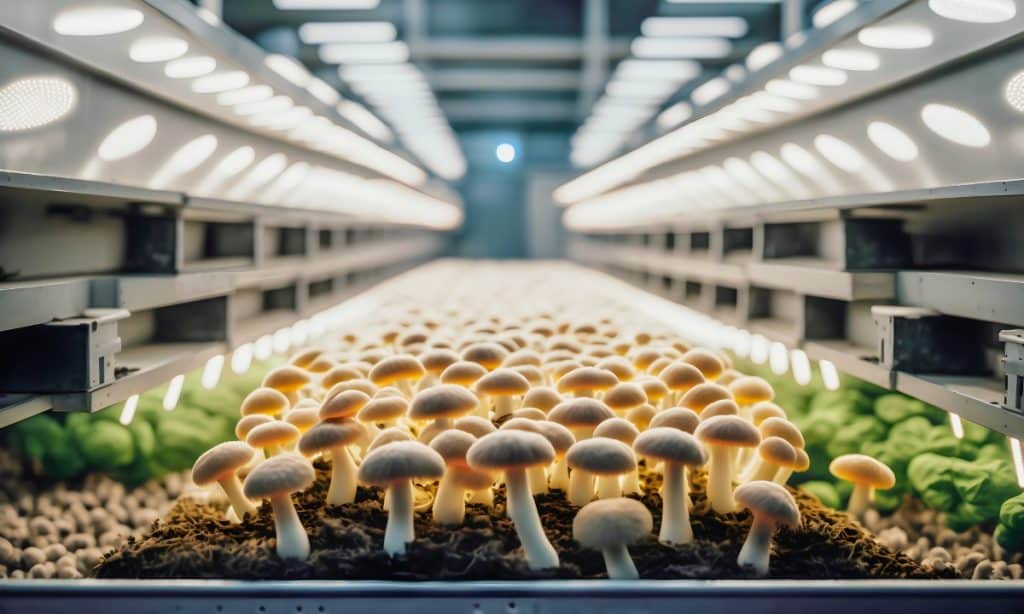
Pros and Cons of Sunlight
Pros
- No cost
- Increases the vitamin D content
Cons
- The amount of light varies depending on weather conditions
- It may be too hot and dry out the mushrooms
- Not easy to provide in controlled fruiting room conditions

How Much Light Do Mushrooms Need?
Exactly how much light mushrooms need is not clear. Some say it can be as little as 2 hours a day, but generally, growers agree it’s best to provide 10 to 12 hours of light daily.
Lack of pin development, long stems and pale coloration are all signs that your mushrooms may not have enough light.
Can Mushrooms Get Too Much Light?
Too much light doesn’t usually cause a problem during fruiting unless it’s direct sunlight, as this could dry your mushrooms out.
But exposure to a lot of light during the incubation phase can cause early fruiting, so it’s best to let your mushrooms incubate in a dark spot away from drafts.
How Much Light Do Oyster Mushrooms Need?
Oyster mushrooms will not grow well in the dark. They need 10 to 14 hours of indirect or artificial light daily to produce good quality, high yields.
A study on the effect of lighting on oyster mushrooms showed that it’s not only the amount of light that affects yields but also the light intensity and type of lighting used.
Interestingly, the scientists found that light intensity affected the cap size and stem length the most.
Do Mushroom Kits Need Light?
Yes, mushroom grow kits need light during the fruiting phase of mushroom growth.
Ready-to-grow mushroom kits usually come with the initial phases of mushroom growing completed, ready for fruiting.
To trigger mushroom pinning, the formation of baby mushrooms, you’ll need to place the kit in fruiting conditions and maintain these conditions while the mushrooms grow.
Light, airflow, temperature and humidity are all factors that play a role in ideal fruiting conditions, and depending on the species, it’s often not difficult to create these conditions indoors.
For easy-to-grow species like oyster mushrooms, a warm spot near a window with 12 hours of indirect light usually provides the required temperatures, airflow and lighting.
And misting your mushrooms frequently with water will help to maintain the required humidity levels.
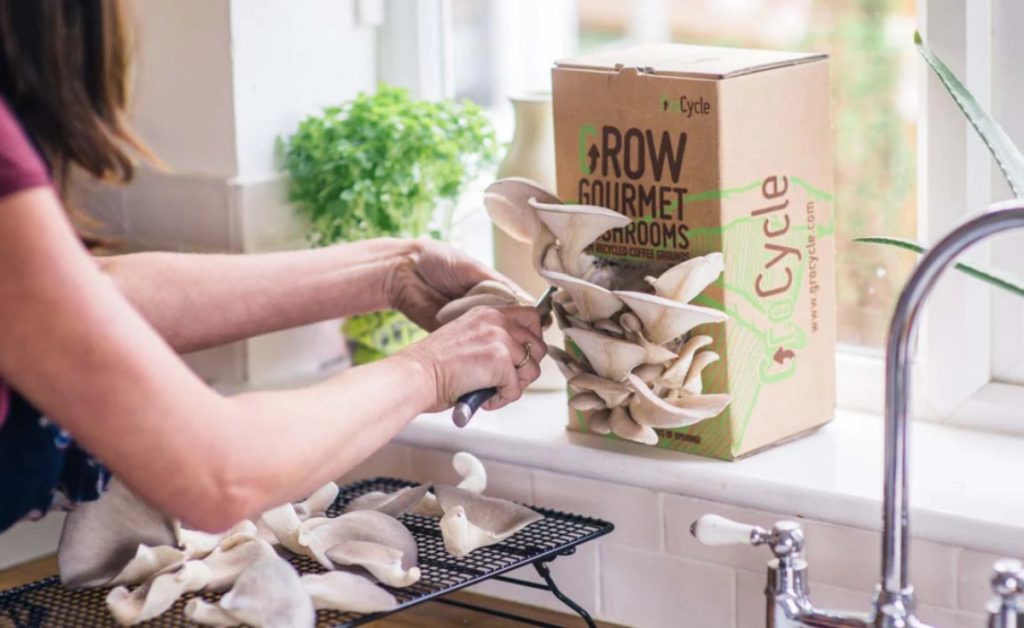
Mushrooms That Tolerate Sunlight
Although most mushrooms grow best in shady locations with indirect or filtered sunlight, some well-known species grow in partial or full sunlight, including:
1. Wine Cap Mushrooms (Stropharia rugosoannulata)

Delicious wine cap mushrooms are large, easy-to-grow mushrooms that get their romantic name from their rich burgundy caps.
They also have several other names, including King Stropharia, garden giant, burgundy mushroom, Godzilla mushroom, and Stroph.
Wild wine caps grow on wood chips in forest clearings in late summer and fall throughout Europe and North America.
These distinctive mushrooms enjoy partial sunlight and won’t fruit in areas with dense shade, making them popular with gardeners who grow them in outdoor beds.
You can even plant them with other vegetables in beds with a thick layer of wood chip mulch, and they appear to help improve the soil.
Although wine caps tolerate sunlight, they grow best in humid environments, and it’s important to ensure their woodchip substrate does not dry out.
2. Elm Oyster Mushrooms (Hypsizygus ulmarius)
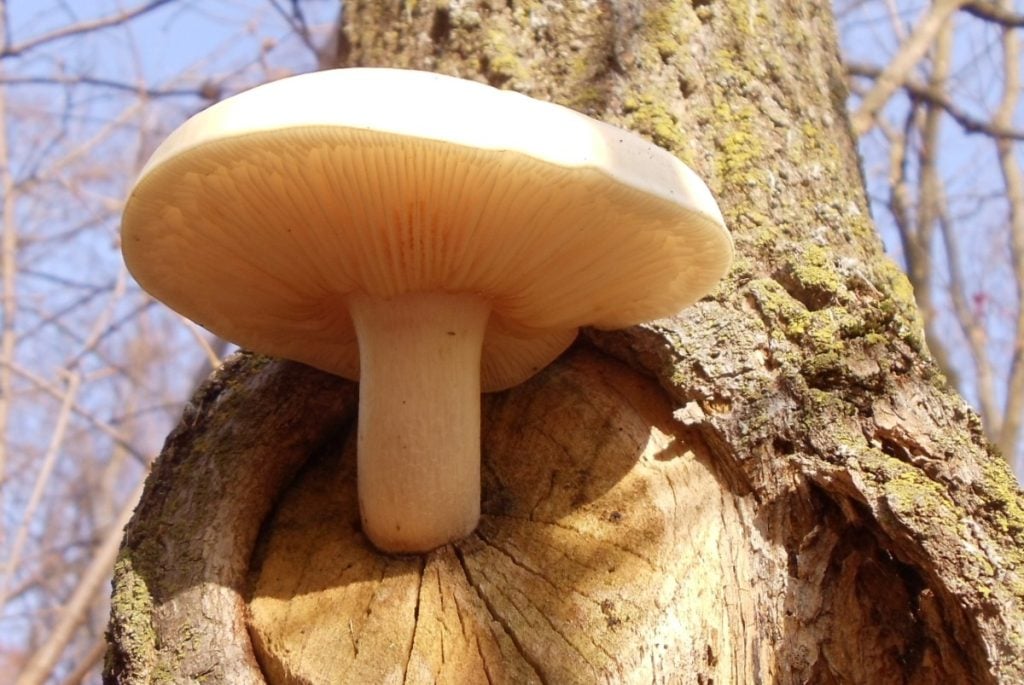
Elm oyster mushrooms are edible oyster-shaped mushrooms, and although not the same species as regular oyster mushrooms, they’re also easy to grow and delicious.
You’ll find elm oyster mushrooms in late summer and fall, high up on the trunks and branches of deciduous trees, especially elms.
As they grow high up, it’s not always easy to forage for elm oysters in the wild, but fortunately, they’re almost as easy to grow as other oyster mushrooms.
You can grow hardy, fast-growing elm oysters indoors on sawdust blocks or outdoors on logs, and they’ll tolerate areas with partial sunlight.
3. Shaggy Mane Mushrooms (Coprinus comatus)

These common edible mushrooms are often found on lawns and roadsides in suburban areas in late summer and fall, and they happily tolerate full sun.
Also known as shaggy ink caps or lawyer’s wig mushrooms, shaggy mane mushrooms have distinctive conical caps with upturned scales that autodigest into inky black goo when they mature.
Young shaggy manes are sought after for their delicate, buttery taste, but harvesting ink caps also triggers autodigestion, so you’ll need to cook and enjoy them as soon as possible.
4. Giant Puffball Mushrooms (Calvatia gigantea)
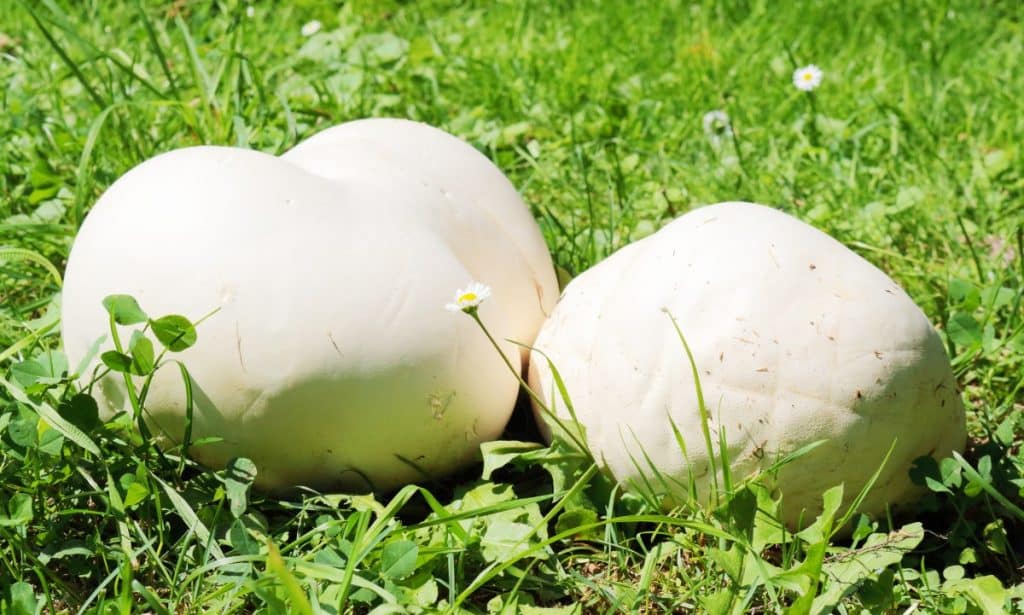
Giant puffballs are the most well-known of all puffball mushrooms and are commonly found in open areas, including grassy meadows and fields, well-fertilized lawns and golf courses.
Puffballs don’t have stems and caps like most other mushroom species. Their spores form in the middle of the round ball-like mushroom.
Young puffballs are edible, but you need to harvest them before they begin to form spores. To check, cut the puffball in half. The flesh inside should be thick, hard and solid white.
If the inside of the puffball is soft, brownish, or full of spores, it’s too mature to eat.
5. Cremini Mushrooms (Agaricus bisporus)
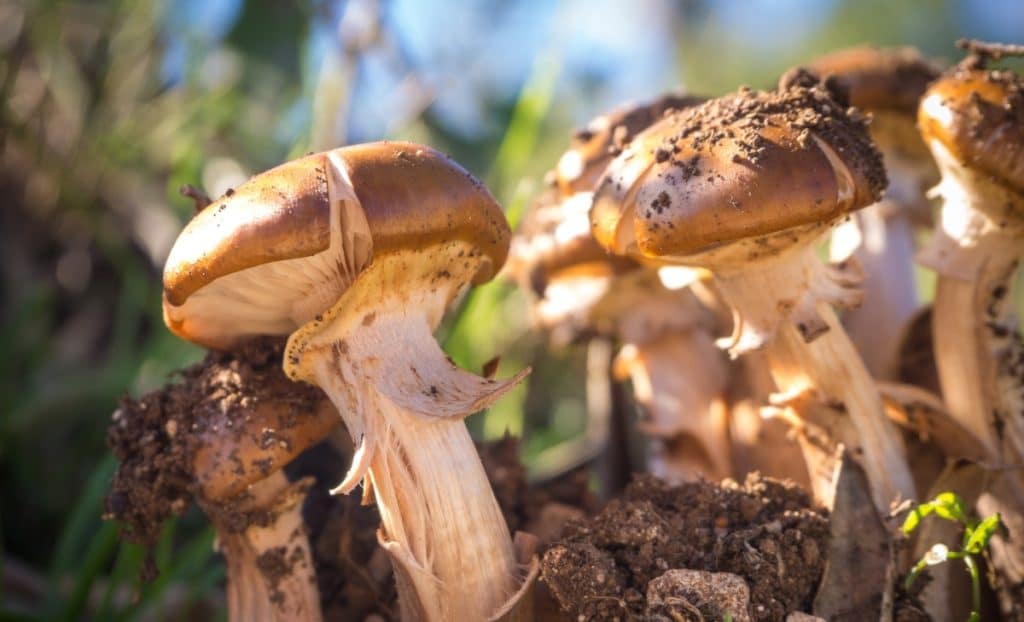
Button, cremini and portobello mushrooms are the same species. The difference is how they’re grown and when they’re harvested.
Farmers allow creminis to mature longer than button mushrooms, resulting in larger mushrooms with brownish caps and more intense flavors.
Most Agaricus species of mushrooms can tolerate sunlight, including Agaricus bisporus. To create the white caps we associate with button mushrooms, farmers cultivate them in the dark.
In the wild, Agaricus species often grow in manure in open grasslands, giving them the name field mushrooms.
But as it’s difficult to tell them apart from toxic amanita mushrooms, it’s safer to grow your own or buy them at your local grocery store rather than forage for them.
What Are The Best Conditions to Grow Mushrooms?
In the wild, fungi won’t produce mushrooms unless environmental conditions are right. They can remain dormant for many years, waiting for suitable conditions.
To grow mushrooms year-round, farmers use fruiting chambers to mimic the natural conditions that cause fungi to pin and produce mushrooms.
The ideal growing conditions vary from species to species but generally include
- A nutritious growing medium
- Optimal temperatures
- High humidity
- Fresh air exchange
- Correct lighting
Our guide to the conditions needed for mushrooms to grow has more information for you.
Final Thoughts
Whether you’re a beginner growing mushrooms for the first time or an experienced farmer with a walk-in fruiting chamber, you’ll need to provide light for your mushrooms.
The ideal amount of light varies from species to species, but generally, most mushrooms grow well with 10 to 12 hours of indirect natural or artificial LED light.
Providing fruiting conditions may seem intimidating, but it’s not as complicated as you think.
Our introductory course to growing oyster mushrooms at home shows beginners how to grow mushrooms using simple methods and minimal equipment.
And our Low Tech Mushroom Farming course is ideal for those who want to get more in-depth with mushroom growing without needing expensive equipment, tons of research or lots of space.
